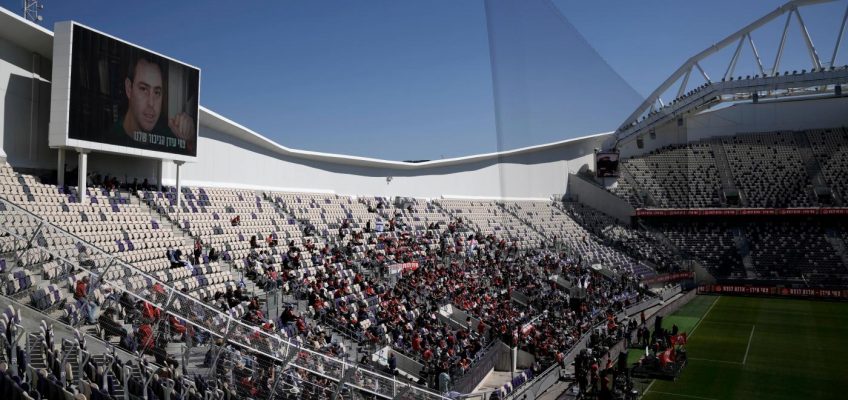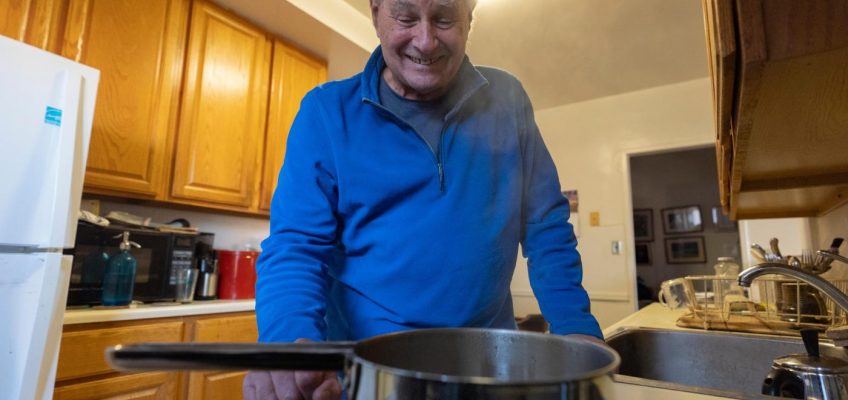By JULIA FRANKEL
JERUSALEM (AP) — Mourners in Israel on Friday were burying the remains of one of the final hostages released in the first phase of the ceasefire between Hamas and Israel, as negotiators discussed a second phase that could end the war in Gaza and see the remaining living captives returned home.
Related Articles
Watch: Trump and Vance call Zelenskyy ‘disrespectful’ in Oval Office meeting
Israel’s army admits failures on Oct. 7. Its probe of the attack could put pressure on Netanyahu
Pope had coughing fit, inhaled vomit and his prognosis remains guarded, Vatican says
Russia offers to restore direct air links with the US, during Istanbul talks
Zelenskyy leaves White House without signing minerals deal after Oval Office blow up
The funeral procession for Tsachi Idan, an avid soccer fan who was 49 when he was abducted by Hamas, began at a Tel Aviv football stadium en route to the cemetery where he was to be buried in a private ceremony.
The office of Israeli Prime Minister Benjamin Netanyahu has said Idan, taken from Kibbutz Nahal Oz during the Hamas-led Oct. 7 2023 attack that sparked the war in Gaza, was killed in captivity.
His body was one of four released by Hamas early Thursday in exchange for over 600 Palestinian prisoners, the last planned swap of the ceasefire’s first phase, which began in January. Hamas has been designated a terrorist organization by the United States, Canada, and European Union.
Idan was the only one of his family taken to Gaza. His eldest daughter, Maayan, was killed as terrorists shot through the door of their saferoom. Hamas fighters broadcast themselves on Facebook live holding the Idan family hostage in their home, as his two younger children pleaded with them to let them go.
“My brother is the real hero. He held on,” Idan’s sister, Noam Idan ben Ezra, said in an interview on Israeli radio Friday. She said Idan had been “a pace away” from being released during a brief ceasefire in November 2023, when more than 100 of the 251 people abducted on Oct. 7 were released.
People attend a public memorial ceremony for slain hostage Tsachi Idan, a fan of Hapoel Tel Aviv F.C., who was killed in Hamas captivity in the Gaza Strip, at Bloomfield Stadium in Tel Aviv, Israel, Friday, Feb. 28, 2025. Hebrew: “Tsachi Idan – red in the soul.” (AP Photo/Leo Correa)
“Tsachi was forsaken twice. The first time when he was kidnapped from his home and the second time when the deal blew up,” she added. “The fact that Tsachi is not standing next to me today is the outcome of the decision-making and the policy here in Israel. They did not listen to us then, but it’s not too late to listen to us today.”
Concern for remaining hostages
With the first phase of the ceasefire deal set to end Saturday, relatives of hostages still held in Gaza are ramping up pressure on Netanyahu to secure the release of their loved ones.
According to Israel, 32 of the 59 hostages still in Gaza are dead, and there has been growing concern about the welfare of an unknown number who are still alive, particularly after three hostages released Feb. 8 appeared emaciated.
One of the three, Eli Sharabi, said in an interview with Israel’s Channel 12 Friday that he and other hostages had been held in iron chains, starved and sometimes beaten or humiliated.
“During the first three days, my hands are tied behind my back, my legs are tied, with ropes that tear into your flesh, and a bit of food, a bit of water during the day,” he said, in one of the first interviews by a hostage released under the current deal. “I remember not being able to fall asleep because of the pain, the ropes are already digging into your flesh, and every movement makes you want to scream.”
Sharabi found out after his release that his wife and daughters had been killed during the Oct. 7 attack.
The next phase of the ceasefire
Under the terms of the truce Israel and Hamas agreed to, Phase 2 of the ceasefire is to involve negotiations on ending the war that has devastated the Gaza Strip. That includes the return of all remaining living hostages and the withdrawal of all Israeli troops from the Palestinian territory. The return of the bodies of the remaining deceased hostages would occur in Phase 3.
Hamas said in a statement released Friday that it “reaffirms its full commitment to implementing all terms of the agreement in all its stages and details.” It called on the international community to pressure Israel to “immediately proceed to the second phase without any delay or evasion.”
Officials from Israel, Qatar and the United States have started “intensive discussions” on the ceasefire’s second phase in Cairo, Egypt‘s state information service said Thursday. Netanyahu’s office confirmed he had sent a delegation to Cairo. Israel has reportedly been seeking an extension of the first phase to secure the release of additional hostages.
“The mediators are also discussing ways to enhance the delivery of humanitarian aid to the Gaza Strip, as part of efforts to alleviate the suffering of the population and support stability in the region,” said the statement from the prime minister’s office.
Israel’s negotiators will return home Friday night, said an Israeli official, speaking to The Associated Press on condition of anonymity to discuss the closed-door talks. Negotiations are set to continue Saturday, the official said. But it was not clear if the Israeli team would travel back to Cairo to attend them.
United Nations Secretary-General Antonio Guterres said Friday that the coming days are “critical,” and urged Israel and Hamas to fulfill their commitments.
The first phase of the ceasefire saw 33 hostages, including eight bodies, released in exchange for nearly 2,000 Palestinian prisoners. Netanyahu has vowed to return all the hostages and destroy the military and governing capabilities of Hamas, which remains in control of Gaza. The Trump administration has endorsed both goals.
But it’s unclear how Israel would destroy Hamas without resuming the war, and Hamas is unlikely to release the remaining hostages — its main bargaining chips — without a lasting ceasefire. After suffering heavy losses in the war, the group has nonetheless emerged intact, and says it will not give up its weapons.
The ceasefire, brokered by the United States, Egypt and Qatar, ended 15 months of war that erupted after Hamas’ 2023 attack on southern Israel that killed about 1,200 people.
Israel’s military offensive has killed more than 48,000 Palestinians, according to Palestinian health officials, who don’t differentiate between civilian and combatant deaths but say over half the dead have been women and children.
The fighting displaced an estimated 90% of Gaza’s population and decimated the territory’s infrastructure and health system.
Palestinians prepare for Ramadan amid destroyed homes
Palestinians who returned to destroyed homes in Gaza City started Friday to prepare for Ramadan, shopping for essential household goods and foods. Some say the Islamic holy month feels better than one spent last year, but still far from normal.
“The situation is very difficult for people and life is very hard. Most people — their homes have been destroyed. Some people can’t afford to shop for Ramadan, but our faith in God is great as he never forgets to bless people,” said Gaza City resident Nasser Shoueikh.
Ramadan is a holy Islamic month during which observant Muslims around the world practice the ritual of daily fasting from dawn to sunset. It’s often known for increased prayers, charity and spirituality as well as family gatherings enjoying different dishes and desserts during Iftar, when Muslims break their fasting, and Suhoor, the last meal before sunrise.
Associated Press writer Tia Goldenberg in Tel Aviv contributed.
Follow AP’s war coverage at https://apnews.com/hub/israel-hamas-war




